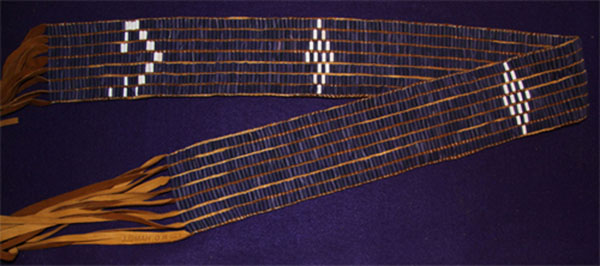 |
 |
 |
Photographs (left to right): All Arches National Park, Utah
Wampum Belt Archive
Chief Condolence Belt

Courtesy New York State Museum

Reproduction R. D. Hamell
March 04 2013
Original Size: |
Length: 40 inches. Width: 2.2 inches. Rows: 7 wide. Rows: 246 by 7. |
Reproduction: |
Beaded length: 41.5 inches. Width: 3.2 inches. Total length with fringe: 65.5 inches |
Beads: |
Rows: 246 by 7 beads wide. Total: 1,722 beads. |
Materials: |
Warp: Leather. Weave: Artificial Sinew. |
Description:
A dark purple belt woven on buckskin thongs. It bears the designs of two white diamonds and a horizontal V-shaped figure in white at one end.
Dark wampum belts were used in mourning councils when the ceremony of "raising up" new names and sachems (hoyaneh) took place. The custom in these ceremonies dictated that one clan should do the mourning, while the opposite clan condoled. These two clans may be represented by the diamond figures, while the V-shaped figure may signify the spreading antlers or "horns," the emblem for authority" or "power."
“The mourning ceremony for a fallen Chief is both to console the mourning brotherhood and on the 10th day to install a successor to carry the Chieftain name and duty of that office. The belt shows two diamonds signifying the Elder Brothers (Mohawks, Senecas, Onondagas) and the Younger Brothers (Oneida, Cayuga, Tuscarora). The V design at one end signifies the symbol of chieftainship. The successor is chosen by the women. Much protocol is involved in the condolence ceremony, from the singing of the Song of Peace as the condoling Chiefs and the people following the singer journey toward the mourning Chiefs, to the installation of the candidate Chief” (Bardeau, 2011).
This belt was believed to have been owned by Blacksnake.
Reference:
Anderson, Lisa. 2013. Personal Communications. NYS Museum.
Bardeau, Phyllis Eileen Wms. 2011. Definitive Seneca: It's In The Word. Jaré Cardinal, editor. Seneca-Iroquois Museum Publisher, Salamanca, New York, 443 .
Clarke, Noah T. 1931 New York State Museum Bulletin No. 288, Fig. 30.
 |
 |
 |
 |
 |
 |
 |
 |
|---|